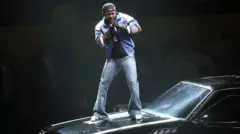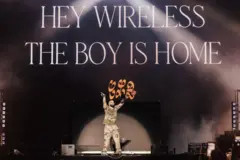Drake, the chart-dominating artist of the last decade, is back with a new album, $ome $exy $ongs 4 U, but it’s not the diss track many might expect after his highly publicized feud with Kendrick Lamar. Instead, Drake seems to be taking a different approach, pivoting back to his R&B roots in what some are calling a “lover-boy comeback”. This strategic move comes after a period of intense public scrutiny and lyrical blows from Lamar, leaving many to wonder if this new musical direction is a calculated retreat or a genuine evolution.
Drake in 2010, standing in front of a plane advertising his debut album, revisiting his R&B origins with his latest release.
Sidestepping the Beef: Drake’s Post-Feud Strategy
Following what many consider a decisive win for Kendrick Lamar in their recent rap battle, Drake’s response has been unexpected. Lamar’s diss track “Not Like Us” became a cultural phenomenon, even topping charts months after its release and being performed at the Super Bowl halftime show. Instead of firing back with a new diss track, Drake has opted for a different path. Crisis PR expert Mark Borkowski describes Drake’s strategy as “intriguing,” noting that he is sidestepping the direct confrontation, focusing instead on “repositioning himself.”
Drake’s new album, a collaboration with PartyNextDoor, is a deliberate shift away from the expected diss track. Apart from a single freestyle seemingly aimed at critics, Drake has largely ignored the feud, choosing to lean into a softer image. While on tour in Australia, he’s been seen embracing his earlier, more sensitive persona, even performing intimate karaoke sets of his older, sultry hits. This move suggests a conscious effort to reconnect with fans on familiar ground, rather than escalating the rap beef.
 Kendrick Lamar performing atop a car at his Super Bowl half-time show, a defining moment in the Drake-Kendrick feud.
Kendrick Lamar performing atop a car at his Super Bowl half-time show, a defining moment in the Drake-Kendrick feud.
Kendrick Lamar performing his Drake diss track at the Super Bowl halftime show, a high point in their rivalry.
$ome $exy $ongs 4 U: A Return to Drake’s R&B Roots
Released on Valentine’s Day, $ome $exy $ongs 4 U is a full-length project that harkens back to Drake’s early, R&B-infused sound. Borkowski characterizes this as a “calculated retreat into the familiar, comfortable territory” of the “certified lover boy” persona that defined Drake’s initial success with albums like Thank Me Later and Take Care. The album is filled with trap-soul beats and themes of romance, a stark contrast to the aggressive energy of a diss track.
This musical direction is a clear attempt to remind audiences of the Drake who dominated the early 2010s, becoming Spotify’s most-listened-to artist. Even after the success of “Not Like Us,” Drake remains a streaming giant, underscoring his enduring commercial appeal. Borkowski points out that while Drake’s reputation may have taken a hit in certain circles, “commercially, he remains bulletproof.”
Commercial Chameleon: Drake’s Genre-Bending Appeal
Drake’s consistent mass appeal stems from his ability to blend genres, creating a diverse catalog that resonates with a wide audience. With an impressive 45 UK Top 10 singles and over 300 US Hot 100 hits, Drake’s music has incorporated elements of grime, dancehall, and Afrobeat. This “commercial chameleon” approach has allowed him to maintain relevance and adapt to evolving musical landscapes.
According to Borkowski, this adaptability is key to Drake’s continued success. Despite the “clear L” of the Kendrick Lamar feud and the impact of “Not Like Us,” Drake’s ability to shift gears and release music like $ome $exy $ongs 4 U demonstrates his resilience. The track “Gimme A Hug” from the new album seems to explicitly acknowledge this shift, with Drake seemingly waving a white flag in the rap battle, declaring, “[Expletive] a rap beef, I’m tryna get the party lit.”
Chart Performance and Critical Reception of the New Album
Commercially, Drake’s strategy appears to be working. Apple Music reported that $ome $exy $ongs 4 U broke first-day R&B streaming records on their platform. In the official UK charts, the album debuted at number three, with three of its tracks entering the Top 40, including “Gimme A Hug.”
Critical reception, however, has been mixed. Vulture described the album as representing a “yearning pre-beef star finding his footing,” noting its sound as a “conscientiously re-establishing” of his earlier style. Rolling Stone gave the album a three-and-a-half-star review, suggesting it was a “return to form from an artist whose back was truly against the wall.” Conversely, Pitchfork delivered a scathing review, calling it “a desperate album from one of rap’s most notorious narcissists.”
Regardless of the critical divide, Borkowski emphasizes that the album, and particularly “Gimme A Hug,” is not a diss track but rather an “abdication from the fight.” It’s a strategic move recognizing that Drake can still achieve success by shifting the focus to a different musical territory.
The Nostalgia Play: Drake’s Long-Term Strategy
If Drake is indeed stepping back from the rap battlefield, where is he headed? The answer seems to be a strategic embrace of nostalgia. Weeks before the album release, Drake’s Australian tour featured him on stage in a vest with mock bullet holes, followed by a declaration of his enduring presence in the music scene, referencing his career start in 2008.
Music journalist Manu Ekanayake sees the new album’s return to his early 2010s sound as mirroring this nostalgic approach. However, Ekanayake questions whether Drake can successfully revert to his “singing party boy” persona after recent albums that attempted a tougher image.
Drake’s announcement of a three-night takeover at London’s Wireless Festival, each night dedicated to a different era of his career, further reinforces this nostalgia strategy. The event sold out in record time, highlighting the continued demand for Drake’s music across his various phases. Borkowski views this as a “masterclass in reframing,” allowing Drake to “curate his own legacy, reminding people of his longevity, and shifting the conversation away from defeat and back to dominance.”
 Drake previously onstage at Wireless, signaling his enduring appeal and career longevity.
Drake previously onstage at Wireless, signaling his enduring appeal and career longevity.
Drake’s upcoming Wireless takeover is seen as a strategic move to reinforce his legacy.
Ekanayake remains less convinced about the long-term viability of this approach, suggesting that at 38, Drake’s earlier sound may resonate differently. What once felt like a fresh approach to hip-hop might now feel like “the end of something.”
However, Borkowski concludes that Drake’s fanbase is driven by “lifestyle, the vibes, and the brand” rather than strict musical purism. As long as Drake continues to deliver on these aspects, his commercial success is likely to endure. Securing Live Nation for his rebranding efforts further solidifies this power move.
Ultimately, Drake’s strategy is about maintaining relevance and ensuring the continued flow of hits. In the contemporary music industry, perception is a valuable asset, and despite recent challenges, Drake is still leveraging his brand effectively. While Lamar’s “Not Like Us” maintains its momentum, and Lamar achieves historic chart success, the “chart war” is far from over, even if the direct battle has subsided.

